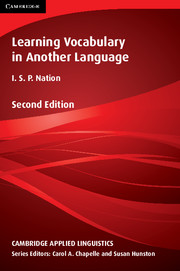Book contents
- Frontmatter
- Contents
- Series editors' preface
- Acknowledgements
- Introduction
- 1 The goals of vocabulary learning
- 2 Knowing a word
- 3 Teaching and explaining vocabulary
- 4 Vocabulary and listening and speaking
- 5 Vocabulary and reading and writing
- 6 Specialised uses of vocabulary
- 7 Vocabulary-learning strategies
- 8 Learning words from context
- 9 Word parts
- 10 Using dictionaries
- 11 Deliberate learning from word cards
- 12 Finding and learning multiword units
- 13 Testing vocabulary knowledge and use
- 14 Designing the vocabulary component of a language course
- Appendices
- Subject index
- Author index
5 - Vocabulary and reading and writing
Published online by Cambridge University Press: 15 February 2018
- Frontmatter
- Contents
- Series editors' preface
- Acknowledgements
- Introduction
- 1 The goals of vocabulary learning
- 2 Knowing a word
- 3 Teaching and explaining vocabulary
- 4 Vocabulary and listening and speaking
- 5 Vocabulary and reading and writing
- 6 Specialised uses of vocabulary
- 7 Vocabulary-learning strategies
- 8 Learning words from context
- 9 Word parts
- 10 Using dictionaries
- 11 Deliberate learning from word cards
- 12 Finding and learning multiword units
- 13 Testing vocabulary knowledge and use
- 14 Designing the vocabulary component of a language course
- Appendices
- Subject index
- Author index
Summary
Reading and the four strands
When looking at language learning in general, or the learning of a particular skill like listening, speaking, reading or writing, it is useful to look at what can make up such a course across the four strands of meaning-focused input, meaning-focused output, language-focused learning and fluency development. About half the time in a reading course should be spent on meaning-focused input which should largely be done through extensive reading, although there are other meaning-focused reading activities which can contribute to this strand (Nation and Yamamoto, 2011). Reading can also contribute to meaning-focused output when learners talk about what they have read or write about what they have read. Meaning-focused output can contribute to reading, when learners gain background knowledge through speaking and writing which can make subsequent reading easier. There are also language-focused learning elements to improving the reading skill, as in intensive reading, the deliberate study of reading strategies, and the deliberate learning of vocabulary for reading. The fluency development strand has a major role to play in a reading course and this fluency development can occur through easy extensive reading, a focused speed reading course and activities like repeated reading. Fluency development should make up about one-quarter of the reading course.
In the reading section of this chapter, we look at how much vocabulary is needed to gain meaning-focused input through reading unsimplified material, how learners can increase their reading vocabulary, the value of reading unsimplified text and simplified text for vocabulary learning, and the value of reading simplified text for improving skill in reading.
- Type
- Chapter
- Information
- Learning Vocabulary in Another Language , pp. 204 - 288Publisher: Cambridge University PressPrint publication year: 2013



